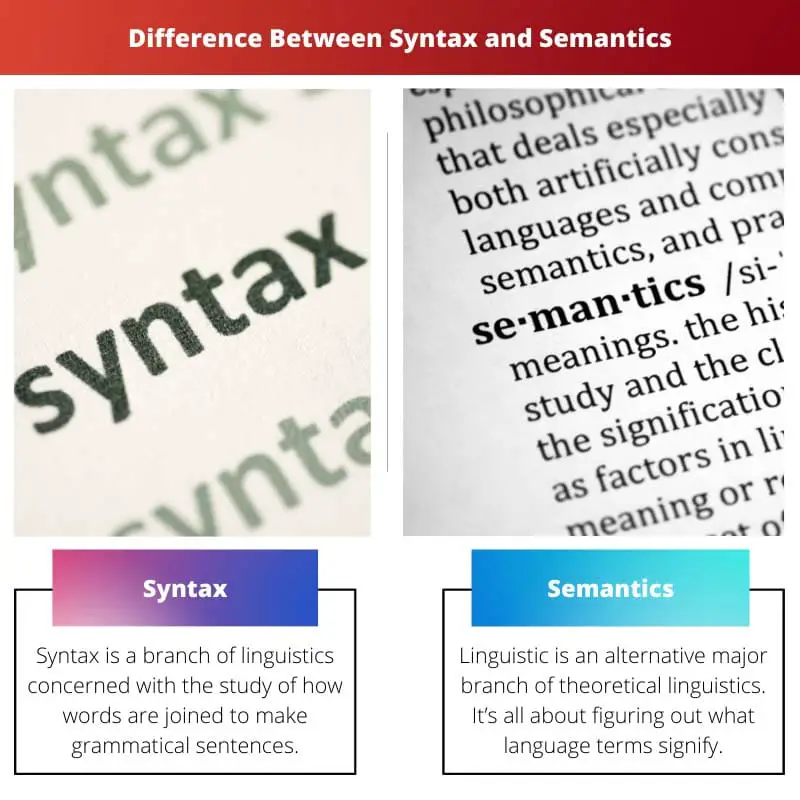In linguistics, syntax, and semantics are two highly significant branches. The study of language is known as linguistics. The syntax is the study of phrase form, whereas semantics is the study of language meaning.
As a result, the primary distinction between syntax and semantics is that syntax deals with structure while semantics deals with meaning.
Key Takeaways
- Syntax refers to the rules and structure of a language, while semantics refers to the meaning and interpretation of language.
- Syntax deals with grammar, punctuation, and sentence structure, while semantics deals with the context and intended meaning of words and phrases.
- Syntax is concerned with the form of language, while semantics is concerned with language content.
Syntax vs Semantics
Syntax describes the rules and principles that govern the structure and arrangement of words to form grammatically correct sentences. Semantics is used to describe the meaning and interpretation of those sentences, including the relationships between words, phrases, and sentences.

The syntax is derived from Greek terms that signify “together” or “arrangement,” as well as “ordered.”
The syntax is the study of sentence creation, describing how words combine to produce larger units than words, such as phrases or sentences. These phrases or sentences are just strings with a correct structure.
Semantics is the study of word and sentence meaning; at its most basic level, it is concerned with the relationship of linguistic forms to non-linguistic concepts and mental representations to explain how language users understand sentences.
Comparison Table
| Parameters of Comparison | Syntax | Semantics |
|---|---|---|
| Origin | Syntax is a phrase originating from Ancient Greek, where syn refers to a group of people and taxis refers to an order. | Semantics is derived from the Greek word seme, which means sigh. |
| Definition | The syntax is a branch of linguistics concerned with the study of how words are joined to make grammatical sentences. | Linguistics is a major alternative branch of theoretical linguistics. It’s all about figuring out what language terms signify. |
| Rule | In sentences, it describes the proper word order and inflectional structure. | It explains the connection between symbols and the things they represent or alludes to. |
| Main Aspect | It shows the order of the word used in a sentence. | It shows the relation between the form and the meaning of the word or phrase. |
| Approach | Its approach toward the meaning of a sentence is based on the grammatical and linguistic correction. | Its approach toward the meaning of a sentence is based on an individual’s interpretation based on prior information. |
What is Syntax?
The grammar rules in sentence structure and how words are ordered to make sentences are referred to as syntax. Subject-verb agreement, accurate word choice, and putting phrases or words in the correct order are all signs of good syntax.
In linguistic communication, a shared language makes it simple for people to express themselves and understand one another, and syntax provides a handbook so that everyone can communicate effectively and quickly using the same grammatical rules.
The syntax may appear to be a theoretical phrase, but its relevance and meaning become evident when applied to language.
Subject-verb agreement: Sentences are frequently constructed with a subject, verb, and direct object.
She chucked the ball,” for example. The subject of this sentence is “she,” the verb is “tossed,” and the direct object is “the ball,” according to the syntactic analysis.
The meaning of this sentence is apparent, and it fits within a natural language shared by English speakers.
Independent and dependent clauses: Independent and dependent clauses are used together in syntax. A stand-alone clause, such as “She tossed the ball,” is known as an independent clause.
A dependent clause is part of a phrase that may provide additional context or support for the independent clause.
Add a dependent clause to make a plain statement more interesting: “After several weeks of building up her strength, she hurled the ball from left field to home plate.”
Everything in that sentence, up to the comma, is a dependent clause that modifies the independent clause.
What are Semantics?
The meaning of a statement is referred to as semantics. The meaning of a sentence would be entirely different without appropriate semantics—and a careful, grammatically accurate sequencing of words.
Linguists divide semantics into several categories, including lexical semantics, which is the study of word meanings and relationships, and conceptual semantics, which is the study of how people who share a language understand and learn semantics.
Consider the statements “She tossed the ball” and “The ball tossed her.” The first sentence’s subject is actively tossing a ball, but a ball is tossing the second sentence’s subject.
Even though the latter is grammatically correct, it makes less sense and does not seem believable.
Deixis: Deixis, or frequent terms that provide context to a place, time, or person, can also be used in semantics.
Deixis can help with semantics or the meaning of a sentence, and words like “yesterday,” “he,” and “here” are examples.
“He’s coming to dinner,” for example, conveys urgency, whereas “He’s coming to dinner tomorrow”—the indexical word being tomorrow—implies that the person or people preparing the meal have more time.
Main Differences Between Syntax and Semantics
- Syntax describes the correct order of words, whereas semantics helps describe the relationships between symbols and things.
- Syntax refers to magical correctness, and semantics refers to providing the correct meaning of the sentence.
- Syntax studies the structure of the sentence, whereas semantics studies the definition and ideology behind it.
- Syntax makes the sentence linguistically, whereas semantics are used by using already known knowledge about the content.
- A syntactically correct sentence is not necessarily meaningful, whereas a meaningful sentence has to be syntactically correct.




